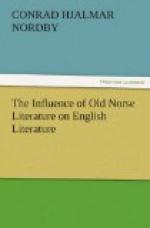Mallet’s work was very bad in its account of the racial affinities of the nations commonly referred to as the barbarians that overturned the Roman empire and culture. Percy, who had failed to edit the ballad MSS. so as to please Ritson, was wise enough to see Mallet’s error, and to insist that Celtic and Gothic antiquities must not be confounded. Mallet’s translation of the Edda was imperfect, too, because he had followed the Latin version of Resenius, which was notoriously poor. Percy’s Edda was no better, because it was only an English version of Mallet. But we are not concerned with these critical considerations here; and so it will be enough to record the fact that with the publication of Percy’s Northern Antiquities—the English name of Mallet’s work—in 1770, knowledge of Icelandic literature passed from the exclusive control of learned antiquarians. More and more, as time went on, men went to the Icelandic originals, and translations of poems and sagas came from the press in increasing numbers. In the course of time came original works that were inspired by Old Norse stories and Old Norse conceptions.
We have already noted that Gray’s poems on Icelandic themes, though written in 1761, were not published until 1768. Another delayed work on similar themes was Percy’s Five Pieces of Runic Poetry, which, the author tells us, was prepared for the press in 1761, but, through an accident, was not published until 1763. The preface has this interesting sentence: “It would be as vain to deny, as it is perhaps impolitic to mention, that this attempt is owing to the success of the Erse fragments.” The book has an appendix containing the Icelandic originals of the poems translated, and that portion of the book shows that a scholar’s hand and interest made the volume. So, too, does the close of the preface: “That the study of ancient northern literature hath its important uses has been often evinced by able writers: and that it is not dry or unamusive this little work it is hoped will demonstrate. Its aim at least is to shew, that if those kind of studies are not always employed on works of taste or classic elegance, they serve at least to unlock the treasures of native genius; they present us with frequent sallies of bold imagination, and constantly afford matter for philosophical reflection by showing the workings of the human mind in its almost original state of nature.”




